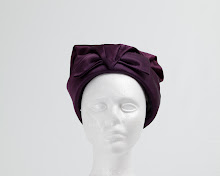Who knew what a production it would be to take photographs of hats. Patrick and I have started the process of taking photographs of my Sara Sue’s, Suzon’s and Tess Cantine hats. The main question is “why do I want to take the photographs?” Do I want an archival record? Yes, I do. I want a record of the hats, the labels, details of the construction, the grosgrain ribbon, the hat pins, the jewelry and other decorative pieces—in short, I want the whole hat recorded for archival reasons. This book is two-fold in its reasoning, I want a good photographic record of the hats to preserve them, and I also want photographs of the hats being worn by women who have a head for hats.
Initially I had covered a Styrofoam head with fabric. I could not find my metal small-headed pins, so I used the big yellow headed quilting pins I use for sewing costumes. After looking at one or two of the hats with cream-colored fabric, Patrick and I thought that the photographs looked not so nice, rather amateurish to be totally frank. The problem was that the head I brought had been damaged. Someone had carved something in the cheek. It was nothing vile, but it was clear that the cheek was scared. My main worry was that the scarring would read as shadows in the photos. We tried black fabric, but that did not work with the grey or black hats. Patrick and I talked about our goals for this part of the project, what did I want from these photos, and the like. Clearly the fabric was not working. Neither the cream nor the black fabric looked good in the sample photographs. In some of the photographs the cream read against the grey and the black made the brim of the darker hats disappear altogether. And then there were the large yellow pins sticking out of the fabric like something created by Dr Frankenstein’s wife in a sewing class. Clearly we were at an impasse. Of course, neither of us thought to just try and see if the scaring on the head would show up in a photograph or not. I am not sure who had the bright idea of trying to take a picture without the fabric to see if this was going to be an issue or not. Of course in the “good” tiff photographs the scaring does show up. I hate to think that we have taken all of these photos in vain, but it has been a learning experience.
Lessons learned:
1. Make sure you have all of your materials first before you cut fabric and try to cover the head.
2. Pick a head that has been marred in any way. This includes carving, drawing, and make up.
3. Make sure you pack a kit bag with scissors, a small tape measure, and writing equipment with you to the photographers.
4. Wear comfortable shoes, or shoes that slide off with ease, because you are going to be on your feet the entire time. That head does not move itself from one view to another or change hats on its own. If it does, you have an entirely different problem, and I am afraid I cannot help with that.

No comments:
Post a Comment